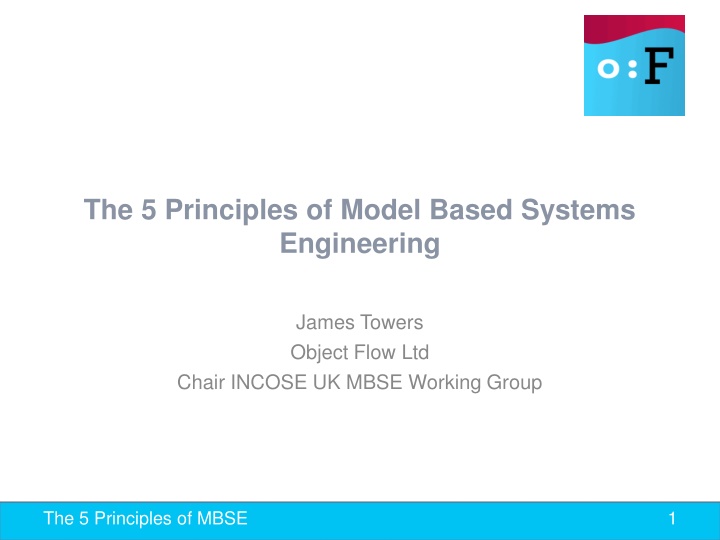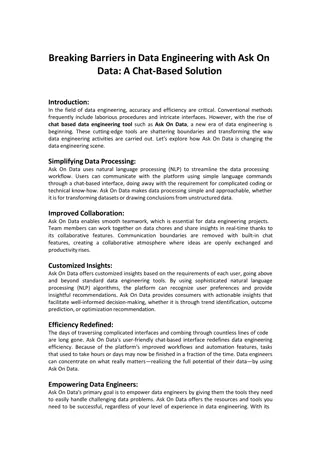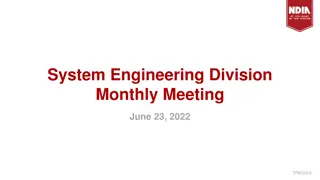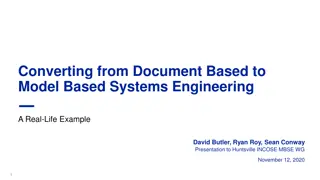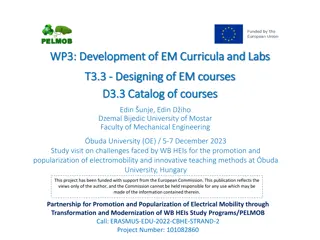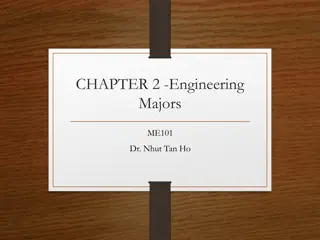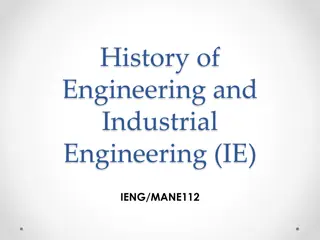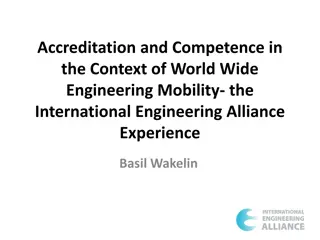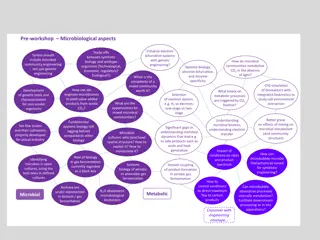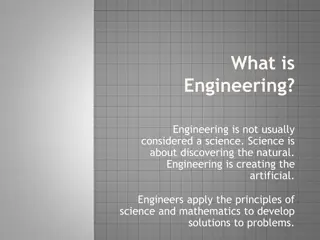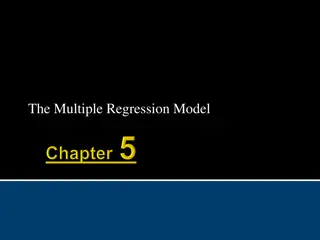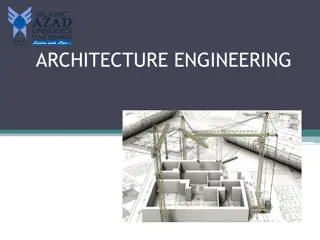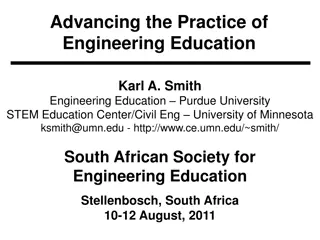5 Principles of Model Based Systems Engineering
Model Based Systems Engineering (MBSE) involves principles focusing on understanding, complexity, spaces, communication, and the Cynefin Sense Making Framework. The principles address challenges related to unknown unknowns, system behaviors, problem-solving spaces, and effective communication strategies in projects. By adhering to these principles, organizations can enhance productivity and efficiency in system development processes.
Uploaded on Mar 16, 2025 | 2 Views
Download Presentation

Please find below an Image/Link to download the presentation.
The content on the website is provided AS IS for your information and personal use only. It may not be sold, licensed, or shared on other websites without obtaining consent from the author.If you encounter any issues during the download, it is possible that the publisher has removed the file from their server.
You are allowed to download the files provided on this website for personal or commercial use, subject to the condition that they are used lawfully. All files are the property of their respective owners.
The content on the website is provided AS IS for your information and personal use only. It may not be sold, licensed, or shared on other websites without obtaining consent from the author.
E N D
Presentation Transcript
The 5 Principles of Model Based Systems Engineering James Towers Object Flow Ltd Chair INCOSE UK MBSE Working Group The 5 Principles of MBSE 1
The 3 Evils (from Holt & Perry) The 5 Principles of MBSE 2
1 A Lack of Understanding (Unknown Unknowns) Applies to both individuals and organisations (projects) The dip in productivity corresponds with the body of the Brontosaurus of Complexity (Holt & Perry) There are unknown unknowns there are things we do not know we don't know (Donald Rumsfeld) The 5 Principles of MBSE 3
2 - Complexity (Plus Simplicity, Complicated and Chaotic) We often use the word complex as a synonym for difficult or no recognisable pattern We should make a distinction between how we define structures and behaviour We can define at least 4 different behaviours of systems Simple = easily knowable Complicated = not simple, but still knowable Complex = not fully knowable, but reasonably predictable Chaotic = neither knowable nor predictable Each of the 3 spaces (Problem, Solution & Project) can behave in a different way (and at different points in time) The 5 Principles of MBSE 4
The 3 Spaces Defines the Problem or Opportunity Specifics the Solution e.g. User Requirements e.g. System Requirements Problem Space Solution Space Shapes the Activity Project Space The Organisations, People, Processes, Standards and Tools used to perform the SE Activity Time The 5 Principles of MBSE 5
Cynefin Sense Making Framework The 5 Principles of MBSE 6
3 - Communication - I dont know what you need to know We can t rely on a process to tell us what artefacts to produce and who to give them to We can t rely on request - response protocols because other stakeholders in the project may not even know we exist, let alone what information we have or require The 5 Principles of MBSE 7
The 5 Principles The 5 Principles of MBSE 8
1 Modelling is more than just drawing bdd [Package] Model, View & Diagram [Model & View] block Diagram Name: Author: Version: Created: Updated: Model & View James Towers 1.0 09/09/2013 18:59:04 06/10/2013 16:28:29 block Architecture block Matrix 1 block Text Document 1..* abstracts is a projection of block System block Model block View block Table 1 1..* 1 1..* 1 1 block Graphical Symbol 1..* 1..* represents block block View element block Text 0..* Model element 1 1..* 0..* is related to block Mathamatical Language The 5 Principles of MBSE 9
2 Each View has a defined purpose and scope There s a temptation when building models to first model everything you know and then model everything you discover It s important to remember that every model is in someway incomplete, and it s this incompleteness that makes it valuable (See Principle 3). Knowing what to omit requires you to know what its purpose is If someone wanted to know how far it was from Tooting Bec to Edgware then consulting the Tube map would be pointless (it wasn t built for that purpose) Purposes include Synthesis, Analysis, Specification, Communication and others Scopes include the Problem, Solution and Project Spaces and others The 5 Principles of MBSE 10
3 The Model adds value The Model is insightful: It can be queried in ways unconnected sources can t. It can be navigated, thus allowing us to discover its content without prior knowledge of what to expect. The Model is more accessible, quicker, cheaper, controllable, adaptable or less risky (in a safety, security and financial sense) to construct and/or interrogate than the real world. The Model is pragmatic: The degree to which it conforms to any of these principles is decided based on risk. The 5 Principles of MBSE 11
4 The Model is of sufficient quality The Model is: Concise - It records one fact in one place (Model Element) Consistent - It doesn t contradict itself Coherent - Its parts produce a unified whole Correct It can be Verified and Validated based on defined criteria It uses abstraction to allow imprecision without inaccuracy The 5 Principles of MBSE 12
5 The Model is constructed from the most appropriate elements Where appropriate the Model is constructed using recognisable and documented patterns May be public or proprietary, general or domain-specific The Model uses the most appropriate languages, paradigms & topologies Languages may include natural language (text), mathematics, general purpose graphical languages (UML, SysML), domain-specific languages and others Paradigms may include functional, object-oriented, symbolic, logical and others Topologies may include graphs, trees, matrices, tables, natural-language (requirements boilerplates) and others The 5 Principles of MBSE 13
The 4 Enablers The 5 Principles of MBSE 14
1 - Architectural Frameworks May be public or proprietary, general or domain-specific Architectural Frameworks enable MBSE by: Ensuring the Model is coherent and consistent, by providing architectural rules and syntax Help us manage complexity and clarify what is important by the use of information portioning and hiding Helps us identify omissions Provides traceability & navigability Aids communication as may be common across multiple projects Define ontologies and standardises concepts The 5 Principles of MBSE 15
2 - Process Frameworks Process Frameworks provide guidelines and principles that allow us to generate a customised process Where appropriate the Enterprise uses recognisable and documented process patterns The Project Team follows a defined System Engineering Process based on one or more of the Process Frameworks All activities within the process involve the Model. All newly discovered Systems Engineering knowledge is recorded in the Model. The Model is shared in a controlled manner Configuration / Version Control Access Control although the default is open The 5 Principles of MBSE 16
3 - People The People involved have the appropriate competencies Complexity (Cynefin) Practices Work Type Skill Level Hot to Achieve Simple Best Assembly Line Proficiency Training Complicated Good Information Fluency Training & Expereince Complex Emergent Knowledge Literacy Deliberate Practice Chaos Novel Concept Mastery Deliberate Practice (10,000 hrs) The 5 Principles of MBSE 17
4 - Tools The tools used have the appropriate capabilities There is a single Model of the System Under Consideration (SUC) i.e. they re modelling not drawing tools They support the required languages, paradigms and topologies and ideally (where possible) can translate between them They support open standards and data formats The 5 Principles of MBSE 18
Questions The 5 Principles of MBSE 19
Acknowledgments Thanks to the following for their contributions, either directly of via published work Tom Riley (Thales) Jon Holt and Simon Perry (Atego) Dave Snowden (Cognative Edge) The 5 Principles of MBSE 20
